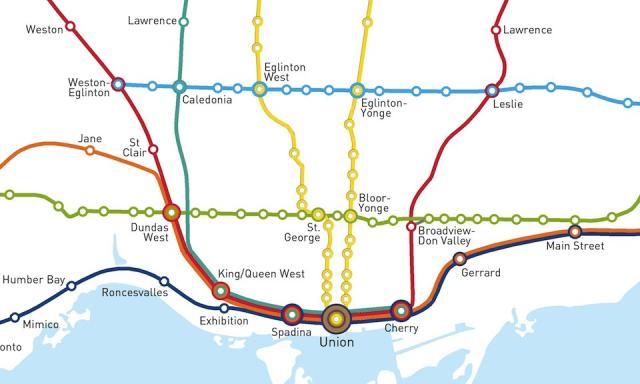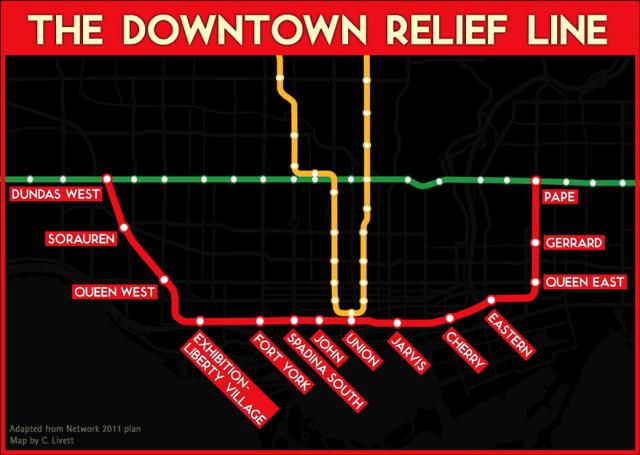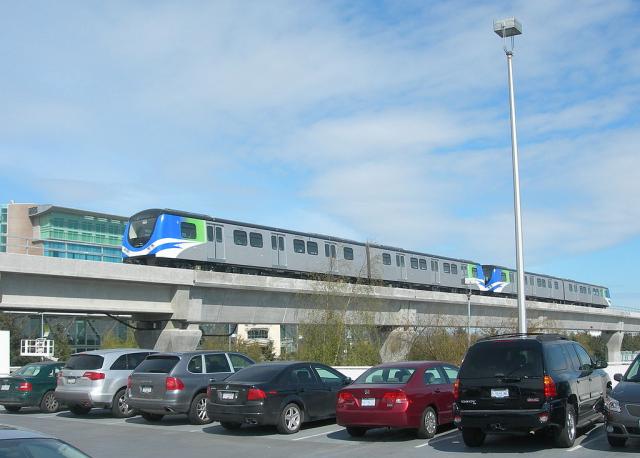Debates over Metrolinx's Big Move returned to the headlines this week with the release of a detailed new report prepared by planner Michael Schabas for the Neptis Foundation. While some observers may dismiss it as “yet another” study of transit in Toronto, we can never have too much information about a plan that will, after all, cost tens of billions of dollars. The report brings some useful and occasionally provocative suggestions to the table and also effectively criticizes some of the weakness of the GTA’s transit planning process. This article will examine some of Schabas’ conclusions.
Regional Rail and Fare Integration
I was extremely pleased to read a detailed assessment of the enormous benefits for reasonable cost that would be produced by real regional rail in Toronto. As Schabas effectively argues, Metrolinx’s GO electrification study was flawed as it concentrated on a mediocre and arbitrary 30-minute frequency that research demonstrates is inadequate to generate the massive ridership increase that comes from passengers not needing to rely on schedules, and because it insisted on the retention of massive 10-car bi-level trains. Both of these assumptions greatly limit the potential benefits of electric multiple unit operation. More importantly, the study did not consider the huge ridership that could be gained by allowing riders to pay the same fare to ride regional rail and local transit. (More on fare integration in an upcoming article)
Schabas’ solution is to maintain a separate fleet of locomotive-hauled bi-levels for peak period service while using smaller electric multiple unit trains to maintain high frequency off-peak. While certainly a better approach than 30-minute infrequent bi-levels all day, it does not correspond with best practices on most real regional rail systems. They manage with a single fleet for peak and off-peak even with far higher ridership than Toronto. Many German S-Bahn systems, for example, move far more people than GO in the peak periods with single-level multiple units. They accomplish this through high frequency, just like the subway, which also moves far more people than GO. Bi-level cars may seem like a reasonable solution to add capacity, but in fact they are one of the biggest causes of capacity limitations on the system: because they take so long to unload at Union Station, headways are severely limited. With a better platform layout and EMU trains with no stairs and more doors per car to speed loading and unloading, frequencies of five minutes or better would be possible. Such a system would be able to move far more people in the peak period than even GO’s massive 12-car trains.
The benefits of EMUs go far beyond shorter headways and reduced emissions; a cutting-edge regional rail multiple unit like the Stadler FLIRT or comparable models from Bombardier would provide dramatic acceleration improvements over existing GO trains. A FLIRT making all stops from Hamilton, for example, would be as fast as existing GO trains from Hamilton running express after Oakville. This would permit the addition of more stops for rapid-transit-style service without sacrificing travel times. (The benefits of electrification will be examined in greater detail in a future article.)
Loco-hauled trains could be retained if necessary for longer distance trains to outlying cities like Kitchener or Barrie, which would likely be limited-stop services where acceleration is less important.
 |
| CityRail Plan central area, cartography by Craig White |
The Downtown Relief Line
The Neptis report goes a bit astray when it examines the Downtown Relief Line. There is no question that real regional rail (not “GO Trains,” as has been reported in the media) would provide significant relief to the subway system. However, that is only one of the many benefits of the DRL.
The DRL would be extremely useful even in the context of CityRail because it would provide service to riders in the few areas that aren’t particularly well served by regional rail. Schabas suggests that riders on the Danforth line could easily transfer to regional rail at Main Street, but that connection is in reality quite awkward. Given that passengers would be required to walk considerably further than the Spadina station connection between Bloor and YUS lines, it is likely that relatively few people would choose it over continuing to transfer at Bloor-Yonge.
The effect on the Yonge Line north of Bloor would also be limited. Most riders on the line, which will become increasingly overcrowded as it is extended north, transfer from connecting bus routes from the east. These riders would switch en masse to a Don Mills extension of the DRL, dramatically reducing congestion on Yonge and providing much better service to riders in that part of the city. Unlike the Georgetown corridor, for example, regional rail in the Richmond Hill corridor would not connect very effectively with surface routes because of its deep valley location.
Finally, the DRL serves some of the fastest-developing parts of the city. The waterfront, East Bayfront, Portlands, Cityplace, and Leslieville areas are all seeing massive growth and development. Furthermore, it serves areas where existing transit service is slow and unreliable. It could reverse the significant ridership declines that the east-west downtown streetcar routes have suffered over the past two decades.
 |
| The Downtown Relief Line, map by Christopher Livett |
The key problem with the cost/benefit case for the DRL as evaluated in the Neptis report is the extraordinarily high cost estimate provided by Metrolinx. The most striking feature of almost all transit planning reports over the past decade is the complete absence of attention to cost control. Very few studies include an examination of different approaches (i.e. underground vs. elevated) or routes and the cost implications. This is in stark contrast with earlier reports, such as the original 1985 Downtown Relief Line study, in which cost was the primary factor being considered when different routes were evaluated. That report concluded that the most economical routing would be along the rail corridor from Bay Street to the Don River, where vacant land is available for a subway. The cost savings would surely be dramatic since virtually no new infrastructure beyond tracks and surface stations would be required in that segment. It would have the added benefit of running right through the heart of the rapidly developing East Bayfront and West Don Lands areas. Such a route does not appear to have been considered in the contemporary DRL reports. The Don Mills segment, as well, is planned to be built entirely underground even though an elevated routing through that area would clearly be feasible and would likely produce enormous cost savings (See "The Rising Cost of Rapid Transit Construction" for more detail). Underground construction costs in Toronto are becoming increasingly out-of-line when compared with peer cities both in Canada and Europe.
Schabas uncovers a particularly striking case of inattention to costs in the Scarborough rapid transit Benefits Case Assessment:
“TTC seems to be requiring a fairly elaborate and expensive yard. The BCA (which was prepared by consultants) notes, ‘The cost of a Vancouver facility with comparable capacity was roughly $200m lower, although the yard alignment and maintenance practices differ from the TTC’s.’ If Metrolinx thinks there may be the opportunity to save $200 million, surely it should give this more attention than a short footnote?” (60)
Automated Light Metro
Certainly one of the most provocative elements of the Neptis report is its advocacy for automated light metro. While the technology has been extremely popular and successfully implemented around the world, in cities as varied as Copenhagen, Paris, London, Vancouver, Tokyo, Moscow, and Madrid, debates about transit in Toronto have remained rigidly within the subway vs. light rail framework.
Part of the blame for the technology falling out of fashion in Toronto comes from the Scarborough RT, which is the only example of automated light metro in the GTA (though the TTC chooses to have an operator in the cab). This is a poor example of the technology, however, that should not discredit an entire approach to transit. Automated light metro does not need to rely on a proprietary technology like the RT with its complicated and sometimes problematic linear induction propulsion system. At its simplest, automated light metro is just a driverless, fully grade-separated train that is lighter and quieter than the subway to facilitate elevated operation when desired.
The Neptis report illustrates a number of significant benefits to the Automated Light Metro technology. Its operating costs over the long term are significantly lower than non-grade-separated light rail since it does not require a driver. The lack of a driver also makes it possible to run shorter trains at maximum frequency all the time for no additional cost. This is a major benefit on less busy routes where the need for a driver could result in unreasonably long waits for passengers. Vehicle costs, in many cases, are also lower than for LRT at a given passenger capacity. Schabas makes the case fairly effectively that automated light metro would be suitable for the Eglinton line, providing faster trips, better frequencies, and greater reliability. Altogether, he persuasively argues that it would provide a significantly better cost/benefit ratio over the long term than the existing LRT plan.
The Neptis report also underplays the enormous importance of transfers from feeder buses in providing the high ridership that makes Toronto’s existing suburban rapid transit so successful. The large majority of riders at Toronto’s suburban subway stations don’t walk to the station from the surrounding neighbourhood; instead, they arrive by bus. There has not been much study about whether bus riders will transfer to a surface LRT that only offers, according to Metrolinx, about 25% faster trips than a bus. This is of critical importance on Eglinton, since if passengers on north-south bus routes decide to stay on the bus until they reach the Danforth line, rather than transferring to the Eglinton Crosstown, it would make the justification of the multi-billion dollar project much weaker.
 |
| Vancouver's Canada Line, image by Michael Berry from Wikipedia |
The Canada Line in Vancouver is an excellent example of an automated light metro line with a comparable capacity and length to the Eglinton Crosstown line (more on this subject here). It is, however, completely grade-separated and so will offer a considerably faster and more reliable trip than a surface LRT that faces obstruction from traffic lights. It is also fully automated, permitting higher frequencies and lower operating costs, particularly off-peak. Built as a public-private partnership, it cost governments $2.5 billion—less than half of the Eglinton Crosstown—and was completed in time for the 2010 Olympics as planned.
Of course, all of these points assume that redesigning the Eglinton line yet again is desirable. Certainly, it would do nothing to dispel the image of disarray that has surrounded many recent Toronto transit projects. It could also bring significant cancellation costs, though they might be reduced if Bombardier is retained to produce the vehicles for the redesigned line. While it is difficult to argue with Schabas when he says that this project will be with us for decades so it should be built right, there are significant costs to halting and redesigning the project yet again and the risk of the useful project falling through entirely is very real.
No comments:
Post a Comment